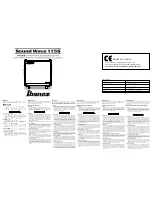
CVP-409/407 Owner’s Manual
207
Appendix
Auto accompaniment chords are recognized regard-
less of the split point or where chords are played on
the keyboard.
• This is normal if the fingering mode is set to “Full Key-
board” or “AI Full Keyboard.” If either of these is
selected, chords are recognized over the entire range of
the keyboard, irrespective of the split point setting. If
desired, select a different fingering mode (page 108).
When playing back one Style and selecting another,
the newly selected Style doesn’t play at the proper
Tempo.
• You can select whether the appropriate tempo will be
called up automatically or not by using the TEMPO
parameter in the STYLE CHANGE BEHAVIOR function.
Starting a Song while playing back a Style stops Style
playback.
This is because Song playback has priority. The two ways
shown below let you play back a Style and Song simulta-
neously.
• Set the Song to Synchro Start standby, then start the
Style.
• Start the Style playback after playing back a Song.
The level balance of the various Parts becomes wrong
or unexpected sounds are output when selecting a
Style or a Voice after selecting a Song.
• The level balance of the Parts can change and unex-
pected sounds can be produced because of the effects
applied to each Part.
The “Off” setting is not shown for the Play Type
parameter in the Assembly (Style Creator) feature.
• The selected section is set to record enable. Release the
recording assignment by pressing the appropriate [1
†
]–
[8
†
] button in the recording channel display (TAB [
√
]
button
→
BASIC tab
→
[F] REC CH).
The channels BASS-PHR2 cannot be edited in Channel
Edit.
• This is normal; BASS-PHR2 channels of the Preset Styles
cannot be edited.
The Song/Style registered to the Registration Mem-
ory cannot be called up.
• If the registered Song/Style is contained on USB storage
device and the USB storage device is not inserted or
connected to the instrument, the Song/Style cannot be
called up. Insert or connect the appropriate USB storage
device containing the Song/Style data.
The order for calling up Registration Memory settings
is not shown on the Registration Sequence setting
display.
• The bank containing the Registration has not been
selected. Select the appropriate bank (page 132).
When using the Freeze function of the Registration
Memory, the On/Off setting of the Left Part does not
change even when changing the Registration Mem-
ory setting.
• The Left Part On/Off setting is included in the Style
group. Remove the checkmark from “STYLE” in the
Freeze setting display (page 133).
Even though a Registration Memory setting contain-
ing a User/USB voice is selected, the File Selection dis-
play shows a Preset Voice.
• This is normal; even with the Preset Voice shown, the
actual sounding Voice is the selected User/USB Voice.
When a User/USB Voice is saved to the User/USB drive,
the actual data is divided into two separate types: 1) the
source Preset Voice itself, and 2) the parameter settings
as set in the Sound Creator. When you recall a Registra-
tion Memory setting containing a User/USB Voice, the
instrument selects the Preset voice (on which the User/
USB Voice is based), then applies the relevant parameter
settings to it—so that your original User/USB Voice is
sounded.
Songs cannot be selected.
• This may be because the language settings have been
changed. Set the appropriate language for the Song file
name.
• If the size of the Song data is large (about 300 KB or
greater), the Song cannot be selected because the data is
too large to be read by the instrument.
Song playback does not start.
• “New Song” (a blank Song) has been selected. Make
sure to select an appropriate Song in the Song Selection
display (page 35).
• Make sure to press the SONG [PLAY/PAUSE] button.
• The Song has been stopped at the end of the Song data.
Return to the beginning of the Song by pressing the
SONG [STOP] button.
• In the case a Song to which write-protect has been
applied (“Prot. 2 Edit” is shown at the upper left of the
Song name), the original file may not be in the same
folder. It cannot be played back unless the original file
(showing “Prot.2 Orig” at the upper left of the Song
name) is in the same folder.
• In case of a Song to which write-protect has been
applied (“Prot. 2 Edit” is shown at the upper left of the
Song name), the original file name may have been
changed. Rename the file with the original file name (so
that “Prot.2 Orig” is shown at the upper left of the Song
name).
• In case of a Song to which write-protect has been
applied (“Prot. 2 Edit” is shown at the upper left of the
Song name), the file icon may have been changed. Songs
to which write-protect has been applied cannot be
played back when the file icon of the original has been
changed.
• MIDI Clock may be set to “EXTERNAL.” Make sure this is
set to “INTERNAL” (page 202).
Registration memory
Song
Содержание 407
Страница 226: ...CVP 409 407 Owner s Manual 226 MEMO ...
















































